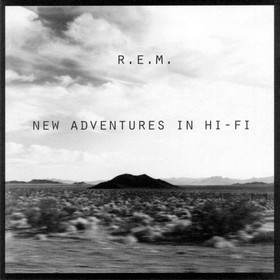 As I said in my last post on 90’s music, my middle/high school years were marked by running into a lot of bands by the third or fourth, or in this case, fifth album. As such, I never experienced R.E.M.’s jangly, pop revolution in their first album trio. The first record I purchased was Monster, an album I like a lot more than this. Whereas Monster feels like an album with a coherent concept that was hard wrought, this album comes across as an indulgent inclusion of outtakes into half of a great record. Before I trash a bunch of the tracks, I’ll start with what I like.
As I said in my last post on 90’s music, my middle/high school years were marked by running into a lot of bands by the third or fourth, or in this case, fifth album. As such, I never experienced R.E.M.’s jangly, pop revolution in their first album trio. The first record I purchased was Monster, an album I like a lot more than this. Whereas Monster feels like an album with a coherent concept that was hard wrought, this album comes across as an indulgent inclusion of outtakes into half of a great record. Before I trash a bunch of the tracks, I’ll start with what I like.
There’s a really great album within the album here, and it’s one that could have been released as an EP that would have been, if not mindblowing, then really a solid 90’s genre piece that capitalized on the grittier side of the sleazebag vibe Beck hit on in Odelay. Michael Stipe has several modes, but when he gets menacing alongside some of the country-western guitars and distortion, it creates a bleak vibe to match the album cover artwork. Without further ado, I give you the real Hi-Fi:
- How The West Was Won And Where It Got Us
- Undertow
- E-Bow The Letter
- Binky The Doormat
- Low Desert
That’s it, man. Right there is all you need from this album. “How the West…” opens with a bizarre narrative that starts in a uranium mine and somehow flashes forward into L.A. (or somewhere like it). I still don’t really get the lyrical progression, but it seems like a kind of alt-narrative of manifest destiny, if that makes any sense. Undertow has some fuzz that pleasantly complicates the general pop refrain, fading out into some seriously good reverb to close the last minute or so of the track.
“E-Bow The Letter” goes full dark-Hollywood, a theme that Stipe would explore further in later records. Patti Smith delivers the backing vocals, doing her best Baby Jane impersonation of the faded ingénue. It might be one of my favorite R.E.M. songs of all time. “Binky” takes a more conventional approach, but the chorus is classic R.E.M., getting a good performance out of the Mike Mills (whose vocals are generally underutilized throughout). Finally, “Low Desert” flashes back to the menace with Stipe as an wandering outlaw, getting out of town just before he ends up in jail. It doesn’t really have refrains per se (just a series of hey, hey’s), but it’s got great lyric writing:
All the ashtrays, cities, and the freeway drives
Broken casino and waterslide
Eighteen-wheeler, payback dice
Gravity pulls on the power lineJet stream cuts the desert sky
This is a land could eat a man alive
Say you’d leave it all behind
And then boom, you’re done, shaking the dust off your jacket. Sadly, this is more of a hybrid, shoehorning in what sound like too peppy rejects from Monster to round out the album. Perhaps my most loathed early R.E.M. song, “The Wake-Up Bomb,” communicates absolutely nothing that I can discern. I think it’s about being hungover after a “Don’t Stop Me Now” kind of night, but if I heard this song come on when I was hungover, with it’s overly enthusiastic percussion and Stipes screeching delivery, I’d rip my speakers out and throw them through the window. Not only that, it drags on for five interminable minutes. I wrote this entire paragraph during the first four minutes of re-listening to this song.
There are a couple of borderline tracks that might have made the cut. “Bittersweet Me” has a good guitar riff and baseline, but the lyrics are a bit lacking. “So Fast, So Numb” is likewise strong, and borders on that faded Hollywood vibe that “E-bow” mastered. The album closes out with “Electrolite,” which has typically beautiful piano playing from Mills, but it flies in the face of “E-bow” without fully establishing the contrast necessary to make it work against the vibe of the earlier tracks on the album.
Now I’ll bag on the rest. “New Test Leper” sounds like Stipe heard Natalie Merchant’s “Wonder” and translated it to the daytime talk show circuit. “Leave” starts with a ponderous slow guitar progression before blasting into some kind of engineered “wah wah” and repeating the same progression in a higher key with an electric guitar. Stipe borders on rock messiah, stadium filler territory here, channeling the worst of Bono. In further pomposity, there is a track near the end entitled “Zither” that consists solely of a solo using a Zither. I rest my case.
I read that this record was put down during sound check before tour dates. Hard miles on the road, the emptiness of the stadium, and the hollowness of stardom all add positive elements to the stronger tracks. It’s a pity that there was no one to edit out the rest.

